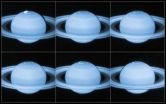(Press-News.org) Scientists have used small-angle neutron scattering (SANS) and neutron spin-echo (NSE) techniques for the first time to understand how monoclonal antibodies (mAbs), a class of targeted biopharmaceuticals used to treat autoimmune disorders and cancer, dynamically cluster and move in high concentration solutions. Certain mAb cluster arrangements can thicken pharmaceutical solutions; they could thus limit the feasible concentration of injectables administered to patients around the world. The insights provided by a team of neutron scientists from the National Center of Neutron Research (NCNR) and the Institut Laue-Langevin (ILL), in collaboration with colloid and proteins scientists at the University of Delaware and biopharmaceutical company Genentech (a member of the Roche group), are an important step towards the development and manufacture of high-concentration biopharmaceuticals needed for high-dose indications and potential self-administration at home.
Monoclonal antibodies (mAbs) are proving to be a vital tool in modern pharmacology, providing the basis for a growing number of successful drugs for cancer and autoimmune disorders such as arthritis and multiple sclerosis. As agents for targeted therapy with a good safety profile, they are an alternative to harsher chemotherapy treatment.
The mAbs work by attaching themselves to specific protein targets on cancerous cells, or blocking target proteins in a known biochemical pathway responsible for a disease. These treatments usually require high doses, and lately in some indications there has been considerable interest in moving from intravenous (IV) delivery to a more convenient subcutaneous (SC) delivery - a shallow injection into the cutis just below the skin (such as the home treatments offered to sufferers of type 1 diabetes). However, progress has been hampered by the high viscosity of solutions containing high amounts of mAbs, and this provides challenges to efficient and economical large-scale production, purification, and delivery of these drugs.
"For some proteins at concentrations higher than 100 mg/ml, you can't deliver them fast enough through thin, SC injection needles, so repeat visits to the hospital with intravenous drips are needed," explains Prof. Yun Liu from the National Center of Neutron Research (NCNR) in the US, who is also affiliated with the University of Delaware. "The thickening may also cause problems in processing, when filtration pressures are too high, for example, or during freeze and thaw in large tanks where potential gelation or phase separation of the freeze concentrate can occur."
As a result, efforts to find ways to raise the concentration of monoclonal antibody pharmaceuticals are focused on understanding the root cause of this thickening. Previous studies using static light scattering (Lilyestrom et al, 2013) on concentrated mAb solutions had suggested a strong link between the development of protein clustering formations and increases in viscosity.
In this latest study (Yearley et al. 2014) led by Prof. Yun Liu (NCNR) and Dr. Dan Zarraga from Genentech, in collaboration with the Institut Laue-Langevin (ILL) in Grenoble, small-angle neutron scattering (SANS) and neutron spin-echo (NSE) techniques were used to study the structure and dynamics of mAb clustering responsible for the bulk solution properties. Two types of antibody were placed in solution - one known to increase solution viscosity and one which did not - so any differences in behaviour could be observed. Neutron spin-echo (NSE) measures cluster dynamics by determining their self diffusivity (as opposed to collective diffusivity measured in dynamic light scattering). Neutrons are able to probe very high concentrations since they are scattered only by nuclei (these occupy very little space and thus appear dilute in the neutron beam's perspective). Also the unrivalled high resolution and very high neutron intensity provided by the ILL neutron spin-echo instrument IN15 allowed a systematic exploration of many different mAb samples.
Using this technique for the high viscosity mAb solution the team confirmed the presence of small extended clusters of mAbs with lifetimes sufficiently long to have an impact on bulk solution properties. On the other hand, the diffusivity measured for the low viscosity mAb solution indicated no such clustering at timescales greater than 50 nanoseconds. The two mAbs only differed in the sequence of their complementarity determining region (CDR); this shows that seemingly small changes in the sequence can have profound consequences on mAb solution behaviour.
Taking into account these insights on mAb clustering, recent studies (Zarraga et al 2013; Allmendinger et al 2014) have shown that there is a window of expulsion rates through a thin needle that reversibly disrupts these mAb clusters, helping mitigate the viscosity issue without irreversibly damaging the individual mAbs. This provides a basis for designing an optimal device system for delivering biopharmaceutical injectable solutions at very high concentrations.
The progress made in these studies is due in part to bringing research institutions and industry together to address practical problems. Research institutions in academe and national labs are often in search of applications for their technological solutions, whilst industry encounters practical problems when looking for solutions. In addition, such collaboration can spur research in adjacent, often very important, fields.
Dr Peter Falus, instrument scientist at ILL said: "Whilst the potential impact of these studies on drug design is very exciting, the subject of protein clustering is an extremely interesting area in its own right. A lot of well-known phenomena, such as the cataracts in our eyes, or Alzheimer's disease, are the results of proteins clustering in our bodies. As a physicist, I am interested in clustering in general, and neutron techniques here at the ILL provide a unique, high-resolution tool to investigate these complex interactions in natural organic systems."
INFORMATION: END
Neutron beams reveal how antibodies cluster in solution
2014-05-19
ELSE PRESS RELEASES FROM THIS DATE:
San Diego county fires still rage
2014-05-19
The San Diego County fires that began on Wednesday May 14 as a single fire that erupted into nine fires that burned out of control for days. According to News Channel 8, the ABC affiliate in San Diego, the following summarizes what the current conditions are for the fires still left burning:
"Cocos Fire - San Marcos: This fire has burned 1,995 acres and is 87 percent contained Monday morning. All evacuation orders and road closures were lifted as of 11 a.m. Sunday, according to the City of San Marcos.
San Mateo Fire - Camp Pendleton: The San Mateo Fire that was reported ...
New technique to prevent anal sphincter lesions due to episiotomy during child delivery
2014-05-19
Results of a 10-year long multinational research project on Technologies for Anal Sphincter analysis and Incontinence (TASI) are available in:
Corrado Cescon, Diego Riva , Vita Začesta, Kristina Drusany-Starič, Konstantinos Martsidis,
Olexander Protsepko, Kaven Baessler, Roberto Merletti
Effect of vaginal delivery on the external anal sphincter muscle innervation pattern evaluated by multichannel surface EMG: results of the multicentre study TASI-2
International Urogynecology Journal, DOI 10.1007/s00192-014-2375-0.
Episiotomy is a controversial surgical ...
Studies published in NEJM identify promising drug therapies for fatal lung disease
2014-05-19
LOS ANGELES (May 18, 2014) – Researchers in separate clinical trials found two drugs slow the progression of idiopathic pulmonary fibrosis, a fatal lung disease with no effective treatment or cure, and for which there is currently no therapy approved by the Food and Drug Administration.
Paul W. Noble, MD, chair of the Department of Medicine at Cedars-Sinai and director of the Women's Guild Lung Institute, is the senior author of the multicenter study that found that the investigational drug pirfenidone significantly slowed the loss of lung function and reduced the ...
EPA ToxCast data validates BioMAP® systems' ability to predict drug, chemical toxicities
2014-05-19
FREMONT, CA (May 19, 2014): Newly published research demonstrates the ability of BioMAP® Systems, a unique set of primary human cell and co-culture assays that model human disease and pathway biology, to identify important safety aspects of drugs and chemicals more efficiently and accurately than can be achieved by animal testing. Data from BioMAP Systems analysis of 776 environmental chemicals, including reference pharmaceuticals and failed drugs, on their ability to disrupt physiologically important human biological pathways were published online this week in Nature ...
Fluoridating water does not lower IQ: New Zealand research
2014-05-19
New research out of New Zealand's world-renowned Dunedin Multidisciplinary Study does not support claims that fluoridating water adversely affects children's mental development and adult IQ.
The researchers were testing the contentious claim that exposure to levels of fluoride used in community water fluoridation is toxic to the developing brain and can cause IQ deficits. Their findings are newly published in the highly respected American Journal of Public Health.
The Dunedin Study has followed nearly all aspects of the health and development of around 1000 people born ...
Chinese scientists crack the genome of another diploid cotton Gossypium arboreum
2014-05-19
Shenzhen, May 18, 2014---Chinese scientists from Chinese Academy of Agricultural Sciences and BGI successfully deciphered the genome sequence of another diploid cotton-- Gossypium arboreum (AA) after the completed sequencing of G. raimondii (DD) in 2012. G. arboreum, a cultivated cotton, is a putative contributor for the A subgenome of cotton. Its completed genome will play a vital contribution to the future molecular breeding and genetic improvement of cotton and its close relatives. The latest study today was published online in Nature Genetics.
As one of the most ...
The young sperm, poised for greatness
2014-05-19
SALT LAKE CITY— In the body, a skin cell will always be skin, and a heart cell will always be heart. But in the first hours of life, cells in the nascent embryo become totipotent: they have the incredible flexibility to mature into skin, heart, gut, or any type of cell.
It was long assumed that the joining of egg and sperm launched a dramatic change in how and which genes were expressed. Instead, new research shows that totipotency is a step-wise process, manifesting as early as in precursors to sperm, called adult germline stem cells (AGSCs), which reside in the testes. ...
'Smoking gun' evidence for theory that Saturn's collapsing magnetic tail causes auroras
2014-05-19
University of Leicester researchers have captured stunning images of Saturn's auroras as the planet's magnetic field is battered by charged particles from the Sun.
The team's findings provide a "smoking gun" for the theory that Saturn's auroral displays are often caused by the dramatic collapse of its "magnetic tail".
Just like comets, planets such as Saturn and the Earth have a "tail" – known as the magnetotail – that is made up of electrified gas from the Sun and flows out in the planet's wake.
When a particularly strong burst of particles from the Sun hits Saturn, ...
Solar energy prospects are bright for Scotland, experts say
2014-05-19
Installing state-of-the-art solar panels on a quarter of a million roofs could meet one-sixth of Scotland's electricity demands, experts say.
Scientists say the strategy could ease the plight of one in three Scottish households, which currently struggle to provide themselves with adequate heat and hot water.
Researchers, business leaders and public sector experts have contributed to a report which sets out how Scotland could benefit from solar power.
They say harnessing energy from the sun on the roofs of south-facing buildings could have significant economic, ...
Antarctica's ice losses on the rise
2014-05-19
Three years of observations show that the Antarctic ice sheet is now losing 159 billion tonnes of ice each year – twice as much as when it was last surveyed.
A team of scientists from the UK Centre for Polar Observation and Modelling, led by researchers at the University of Leeds, have produced the first complete assessment of Antarctic ice sheet elevation change.
They used measurements collected by the European Space Agency's CryoSat-2 satellite mission, which carries an altimeter specially designed for this task.
In sharp contrast to past altimeter missions, CryoSat-2 ...


